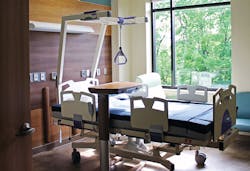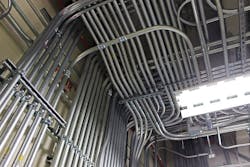The aging of not only the population, but also the nation’s hospitals, is strengthening the health-care market. Case in point: Health care ranked as one of the top three markets for more than half of EC&M’s 2014 Top 50 electrical contractors last year.
In certain pockets of the country, this market is starting to show signs of life again as hospitals are investing in upgrades, building new facilities, and constructing stand-alone clinics. At the same time, however, other major hospitals are still taking a wait-and-see approach due to uncertainty stemming from the Affordable Care Act, says Ken Simonson, chief economist for the Associated General Contractors of America.
“Hospitals have been holding off on some major spending decisions and construction projects until they have a firmer idea of how the hospital utilization and reimbursement rates will be affected,” Simonson says. “By the end of this year, they should know more as the Act is fully implemented.”
Hospitals’ uncertainty and cautiousness to invest in future improvements, however, may have already taken their toll. Due to the extremely reduced investment, the construction industry felt an immediate impact that may take years to overcome, says David Peterson, senior vice president for ERMCO, Inc., an Indianapolis-based electrical contracting firm.
While some health-care providers have put projects on the backburner due to uncertainty, demand is now increasing, and hospitals are realizing they need to do something to keep up with the demand, says Kevin Haynes, senior consultant for FMI Corp. For example, Faith Technologies’ health-care clients are starting to release work and spend money on new projects, says Michael Bowman, a vice president for the Menasha, Wis.-based electrical contracting firm.
In California, upgrading facilities to meet the legislature’s demands for emergency preparedness — primarily structural seismic standards — continues to be the driving force behind new hospital construction, says Ed Noble, director of pre-construction for Helix Electric, a nationwide electrical contracting firm.
“The state government has twice extended the deadline for compliance, with 2020 now representing the deadline,” he says. “Most major facilities have found that replacement is a better value than retrofit. California can expect to continue to see a strong health-care construction market for at least the next five years.”
For electrical contractors interested in health-care market work, here are five key trends that are driving steady growth.
1. Focus on new cabling and connectivity
As hospitals begin investing in upgrades and new construction projects, they are hiring electrical contracting firms to install new cabling to support the latest technology.
For example, due to technological advances, electricians are now facing additional requirements related to pathways and rough-in to accommodate the larger Cat. 6A cable, says Gene Burcham, vice president of the systems group for ERMCO. In turn, this work requires additional coordination with other trades and in the field.
Daniel Holland, president of Star-Lo Communications, says the new trend for hospitals is to install this higher-grade cable to support higher bandwidth access points. Because hospitals are facing new standards in wireless applications and must install a greater density of wireless access points (WAPs), it has generated a lot of work for the company’s low-voltage technicians, who are doubling the number of access points in several local hospitals. In addition, they are increasing the amount of Wi-Fi and cellular coverage for several major hospital wireless networks by installing WAPs in patient rooms and common areas.
To enhance the patient experience, hospitals are also shifting from television over coax cable to television over the Internet. When the television becomes a device on the wireless network, patients can play games or surf the Internet from the comfort of their bed rather than only being able to flip through TV channels.
Furthermore, low-voltage electrical contracting firms must set up two different private networks. A clinical network supports the patients and allows the medical staff to transmit exam results and records electronically to other clinics. An information technology network then handles record-keeping and process-related information technology.
In addition, Holland says his technicians are also setting up a robust wireless network to support the growing number of mobile devices used within the hospitals. For example, the technicians set up a distributed antenna network, which enables cellular service in the hospitals and allows patients and visitors to access the 3G service from their local providers.
“There is so much wireless usage within some hospital facilities that it causes electromagnetic interference on their wired networks,” Holland says. “The trend is to not eliminate the wired connections, but instead to supplement the network with a lot more wireless density and bandwidth.”
2. Reaching out to the community
Another key trend within the health-care market is the emergence of stand-alone emergency clinics, surgical centers, and non-acute care facilities in retail stores, Simonson says.
In some cases, these clinics may be taking business away from the hospitals by directly competing with them, Simonson says. In other situations, however, these free-standing emergency departments are actually affiliated with the major medical systems, Bowman says.
“One of the biggest trends that we are seeing is a focus outside the core institution of a hospital and not the typical independent ‘doc in a box,’” Bowman says. “Instead, we are seeing more of an uptick in free-standing emergency departments — either stand-alone or coupled with a medical office building — as well as outpatient surgical centers.”
One of the key technologies allowing these small clinics to be integrated into the larger hospital’s network of care is the inclusion of Tele-Medicine units, Noble says. These sophisticated audio/visual stations can include an array of metrics permitting specialist clinicians in the home hospital to remotely interact with and evaluate patients in these separate facilities, he says.
By building these new facilities, the major health-care systems can lessen the emergency room wait time, reach out to the outlying community, and treat patients closer to home. Then, if they need to be admitted, they can be transferred to the local hospital, and their personal and medical information is already in the system.
Because these clinics often include a much smaller amount of electrical work than in a traditional hospital construction project, they are starting to open the field to smaller electrical contracting firms, Haynes says. While only a handful of electrical contracting firms may have the capacity and experience to bid on a $300-million hospital project, a smaller project in a medical office building may attract more bidders, he says.
“It allows for new players to come in who haven’t worked with an owner before,” he says. “Then if a company knocks it out of the park on a smaller project, it may get a chance to bid competitively on a larger job when the economy improves and the demand for health care skyrockets.”
3. Reviving aging facilities
Along with building smaller facilities that reach out to the community, hospitals are also hiring electrical contracting firms to upgrade their decades-old aging facilities. For example, hospitals are hiring companies to upgrade finishes, install interactive systems, and improve lighting and controls.
“We are seeing a lot of the facilities investing in remodels, upgrades, and additions to try to get caught up with technology and meet the ever-changing standards and codes,” Bowman says. “Owners are trying to figure out what is the best to spend on today so it won’t be outdated tomorrow.”
For example, a lot of the hospitals that were built in the 1970s and 1980s are behind when it comes to the emergency power requirements. As such, they must be upgraded to comply with current standards, Bowman says.
“Back then, the amount of power required for a given room was one or two outlets or circuits,” he says. “Over time, the emergency power system requirements have become much greater, which, in turn, has taxed the older systems and requires an increase in the overall capacity.”
The hospitals must also implement a preventive maintenance program for their emergency power system and ensure that the equipment is regularly maintained and tested. This requirement is driving more opportunities for electrical contracting firms to manage this maintenance work in the health-care sector, Bowman says.
4. Conserving energy
As hospital administrators renovate their facilities, they often look to save energy and increase efficiency. According to Bowman, two of the main ways they can save energy on the electrical side is by installing more efficient mechanical systems and lighting and control equipment.
“The mechanical systems are one of the biggest users of energy within a hospital, and by moving to more efficient systems and better control, you can see a big difference in the decrease in the overall energy usage,” he says. “Additionally, by integrating the building management systems with new and improved lighting control systems, customers can maximize energy savings as well.”
Faith Technologies is one contractor seeing an increase in the amount of LED lighting on projects, which hospitals are using to illuminate both exterior and interior spaces. Similarly, E-J Electric Installation Co., a Long Island, N.Y.-based electrical contractor, is also installing LED lighting for several of its health-care clients, says Chairman Bob Mann.
Sustainability and efficiency are driving many design decisions in the health-care market, says Peterson of ERMCO.
“Health-care facilities are major power users and operating as efficiently as possible has become critical to their business model,” Peterson says. “Also, with new technology comes a responsibility to protect the health-care industry’s ability to maintain operations through environmental and any other potential interruptions.”
Haynes says while he sees contractors focused on making improvements related to energy efficiency and sustainability, he is seeing a decrease in the number of projects applying to be LEED certified, simply from an economic standpoint.
“The momentum with green building has continued, but people may be less likely to try to get their buildings LEED certified during more difficult economic times,” he says.
By decreasing its energy usage, however, a hospital can decrease the life cycle costs, Haynes points out.
“Owners may see that there are more costs upfront to incorporate the efficient equipment, but at the same time, if they look at those costs over the lifetime of the building, they will see the savings pay off,” he says.
5. Pumping up project productivity
With regard to project management, health-care projects are many times leading the way when it comes to saving money, time, and labor. For example, contractors and economists alike are seeing a focus on prefabrication, building information modeling (BIM), and lean construction on health-care projects.
Faith Technologies has been using prefabrication for several years because it not only makes the electricians more productive in the field, but also because the owners and end-users are requesting it. For example, the contractor has worked on projects where an entire corridor has been prefabricated collaboratively by the trades and then put into place. The firm has also prefabricated entire patient bathrooms as well as electrical rooms including large feeders and panelboards, which are constructed off-site and assembled on-site.
“We push prefabrication to the limit and are looking to take advantage of all the opportunities we can to prefab,” Bowman says.
One way the contractor is able to prefabricate the building components ahead of time is by extracting exact, detailed drawings from a BIM. By fabricating electrical systems ahead of time, the electricians can better meet deadlines, even on projects with accelerated schedules.
“When you perform the work in a controlled environment, it increases safety and quality control, which, in turn, minimizes rework,” Bowman says. “On large projects, trades are often stacked on top of each other, or the electricians must work in tight spaces. By performing as much of the work as possible off-site, you minimize the overlap of multiple trades trying to work in the same area at the same time.”
To handle the increased demand of not only BIM, but also early involvement on projects, Faith Technologies has bolstered its pre-construction staff to more than 100 designers, virtual design and construction (VDC) modelers, engineers, and preconstruction managers to meet its customers’ needs and provide maximum value.
“BIM is a must-do today,” he says. “It is an important component, and owners are looking to have a fully integrated model with all of the major systems.”
Noble says BIM has revolutionized the way MEP systems are built in hospitals, and it goes hand-in-hand with the full implementation of off-site prefabrication.
“When you have a fully developed and coordinated 3D model, you can proceed with massive prefabrication assemblies with the total confidence that those assemblies will fit smoothly into the overall construction plan,” Noble says.
As health-care clients are increasingly requiring their electrical contractors to be proficient in both BIM and prefabrication, they are also taking a lean construction approach to their new construction projects. To minimize cost and maximize value, some of Faith Technologies’ customers are asking the MEP trades to get involved early on in the process for a best-value approach, Bowman says.
Owners are learning, however, that the earlier they engage the MEP subcontractors in the design process, the better their project comes together when they hit the site, Noble says. The organization has had first-hand experience with failures resulting from the old model, and, as such, has consciously worked to increase its pre-construction capacity.
“Lean construction and integrated project delivery in the health-care segment is being driven by owners who have come to see the old design/bid/build model as too cumbersome, costly, and ineffective for large, complex projects like hospitals,” says Noble. “The best preconstruction effort yields the best construction product in terms of quality, time, and value.”
By becoming well-versed in different delivery methods and becoming experienced with BIM and prefabrication, electrical contracting firms can position themselves to take advantage of emerging opportunities in the health-care sector. That way, when the uncertainty dissipates and hospitals release more work, they will have the expertise, available workforce, and technological know-how to win much more work.
Fischbach is a freelance writer based in Overland Park, Kan. She can be reached at [email protected].
SIDEBAR: Influences Affecting Health-Care Construction
Over the last 20 years, health care has been one of ERMCO’s primary markets. The Indianapolis-based firm has participated in many evolutions in the industry — from new hospitals to medical office buildings to tenant renovations. David Peterson, senior vice president, shares four more trends that are not only impacting his firm, but could also affect other contractors in the future.
Shifting to prevention. The health-care industry has undergone many changes over the last few years, Peterson says. For example, he says the transition to preventive care and a minimum for overnight patients has continued to drive the development of clinics and the approach to outpatient and ambulatory care.
Focusing on improving security. In the health-care industry, security is in a critical transition, Peterson says. For example, hospitals are installing card access and video monitoring systems to tighten up information security and access/control of hospital personnel, patients, and visitors.
Serving the aging population. As the health-care needs of the Baby Boomer generation increase, Peterson predicts there will be a drastic increase in the services sought by that population. Cardiology and orthopedics may have the largest noticeable impact, but expectations will shift as hospitals start to focus more on other areas, including the patient experience as a whole.
Customizing solutions. Hospitals are always trying to install the latest technology to better serve their clientele, improve the productivity of their medical team, and compete with other facilities. “Through increased understanding of technology advancements, electrical contracting firms have an opportunity to be more involved in developing these types of solutions,” Peterson says.








